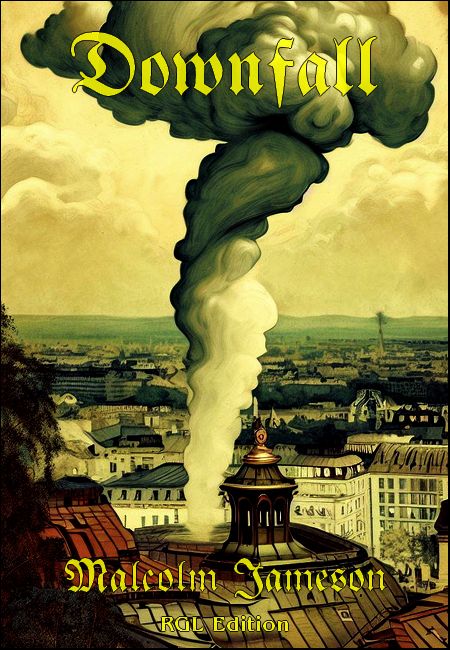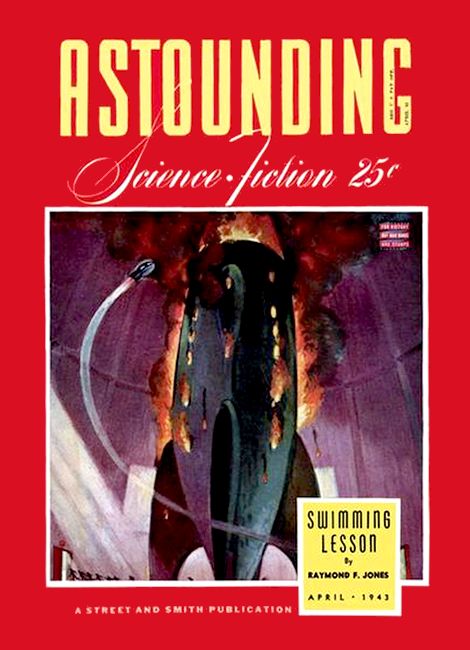
RGL e-Book Cover
Based on an image generated with Microsoft Bing
Roy Glashan's Library
Non sibi sed omnibus
Go to Home Page
This work is out of copyright in countries with a copyright
period of 70 years or less, after the year of the author's death.
If it is under copyright in your country of residence,
do not download or redistribute this file.
Original content added by RGL (e.g., introductions, notes,
RGL covers) is proprietary and protected by copyright.

RGL e-Book Cover
Based on an image generated with Microsoft Bing


Astounding Science Fiction, April 1943, with "Downfall"
WHENEVER Noonan, the former chief technician of the War Inventions Board, saw fit to loosen up and spill some of the inside dope on the last war, we all listened, naturally, though I must say some of the things he let leak out were fanciful beyond belief. So, the night we gathered around the table in the back-room of Jake's place and he asked us if we had ever heard the true lowdown on how the Nazis came to lose the war, we promptly chorused an eager "No." He took a drag at his highball and began.
"We used an Earliwell implosion bomb—the only one that was ever made, by the way. It was a fragile-looking thing, that bomb, something like a bubble dancer's balloon, but at that it weighed enough to start falling, and that was all that was needed. You see, an implosion bomb works on exactly contrary principles from one of the explosive variety; instead of erupting matter with great speed and violence, it inrupts it, getting heavier rather than lighter all the time, so that its terminal weight may be anything. It sucks into itself whatever it comes in contact with—air, water, land, or what have you; whatever it hits ceases to exist except as a freshly incorporated part of the bomb itself.
"We took it over Germany in a bomber, being careful not to touch off its fuse until it was well over the side or otherwise the plane and its crew would be imploded, too—and at the wrong moment. Munich was the target, but when we got there the ack-ack was pretty hot, and since it did not matter particularly where we dropped it, we heaved it over into an empty field. The bomb got away clean and started down very nicely. In fact it fell rather faster than even a solid iron one would have, for there was no resistance from the air. Every molecule of that it encountered promptly became part of the bomb.
"Very well. The bomb hit the ground and went on in. Since the earth melted under it the instant of contact and was at once imploded, the bomb continued on downward in free fall. It was just as if it had been in vacuum. I forget how long it took now, but it was quite a long time before it got to the center of the earth. By then its weight was colossal—probably approaching that of dwarf-star stuff—and it was hitting it up at a terrific rate of speed. So it went on and up, that time, until it hit the bottom of the Pacific and came up and out and went on toward the stars."
"Hey!" protested Charlie Wintergreen, "you can't do that to me. Why didn't it stick at the center of gravity?"
"Why should it?" asked Noonan mildly. "What was there to stop it? Momentum, my boy, is something you can't laugh off, and there was no way to brake the thing since everything it brushed against went out of existence."
Charlie looked doubtful about that, but grunted a little and said go on.
"You may remember that about that time an Anzac patrol cruiser reported a strange maelstrom appearing a few hundred miles south of the Society group? No one could see the bomb emerge, of course, since by its nature it could not entrain water into a waterspout, and was going so fast by then as to be invisible. Likewise, no one followed the bomb up its trajectory, so the explanation of what occurred is purely theoretical. However, the subsequent results bear abundant testimony that what I am telling you is how it happened.
"Some hours later a geyser of superheated steam appeared near Munich, and after that—"
"Now, listen," objected Charlie, a little angry now, "we let you have your way about your fancy bomb. After all, you did provide it with continally increasing inertia. But water simply wouldn't act like that—not if the whole Pacific fell into the hole. It would fall back when it reached the same height on our side."
"Not a bit of it. You forget the water picked up additional oomph on the way, too. Heat, mostly—heat from the earth's core, and also from the friction as it blew past it. Anyway, it came out on the European side with a velocity that was no less than terrible. The superheated steam must have made it to the upper stratosphere in practically nothing flat. And it induced vertical air currents with the effect that for a day or so Germany had a stationary tornado of national proportions. Most of the buildings were blown down by the inrushing surface winds, if you remember. Then came the hail—if you call ice in thousand-ton chunks hail. You see, all that steam hitting the stratosphere had to condense, and when it did it fell back. The ice fall finished what the winds began. The Nazis folded up—what was left of them."
"Why did it quit so abruptly?" challenged Charlie, still unmollified. "It seems to me that as long as there was water left in the Pacific the thing would keep on going."
"Cave-ins," explained Noonan simply, "from both ends of the tube simultaneously. The stuff met itself in the middle and plugged the hole. Now we're back to normal."
"Humph," snorted Charlie. "The history books mention the winter of 1943 as a humdinger with violent gales and heavy snows, but—"
"You wanted the real low-down, didn't you?" asked Noonan. That time he finished his drink in one big swallow.
Roy Glashan's Library
Non sibi sed omnibus
Go to Home Page
This work is out of copyright in countries with a copyright
period of 70 years or less, after the year of the author's death.
If it is under copyright in your country of residence,
do not download or redistribute this file.
Original content added by RGL (e.g., introductions, notes,
RGL covers) is proprietary and protected by copyright.